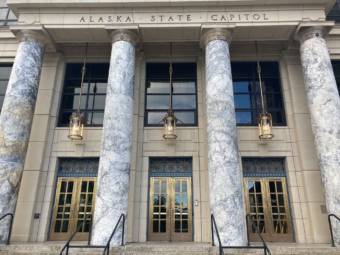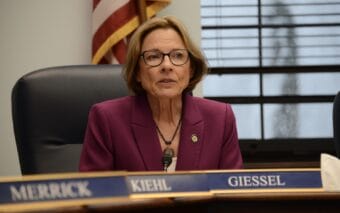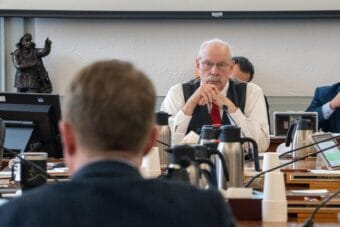
In 2018, state lawmakers made a historic vote to change the way they manage the earnings of Alaska’s Permanent Fund, the $80 billion pool of investments originally seeded with oil revenue.
For decades, the fund’s earnings were spent mainly on dividend checks paid to Alaska residents, with the amounts tied to the rate of returns on the fund’s investments.
The 2018 vote was aimed at modernizing the fund by managing it more like an endowment: Lawmakers would drop the returns-based formula and switch to yearly spending tied to the fund’s value. They set the limit at 5%, which lawmakers described as the maximum that could be sustainably used without reducing the fund’s spending power.
Just three years later, though, lawmakers are closer than ever to blowing past that limit to fill short-term deficits and pay larger dividends. Such a step would, in turn, force future generations of Alaskans to pay higher taxes or enact steeper spending cuts to keep the state’s budget balanced.
In an 11-9 vote two weeks ago, state senators approved spending an extra $1.5 billion beyond the cap to help fund near-record Permanent Fund dividend checks of $2,300.
Meanwhile, Gov. Mike Dunleavy has proposed more robust protections for the fund by putting the 5% limit in the Alaska Constitution — while simultaneously proposing $3 billion in overspending to fill deficits that would linger until lawmakers agree to fill them with taxes or budget cuts.
For the past eight years, following a crash in oil revenue, Alaska lawmakers have been filling multibillion-dollar deficits with money from their other savings accounts.
But those accounts are now effectively depleted, dropping from a combined $16 billion to $1 billion. And that’s making the Permanent Fund’s earnings an increasingly attractive option to lawmakers, who can spend them by a simple majority vote.
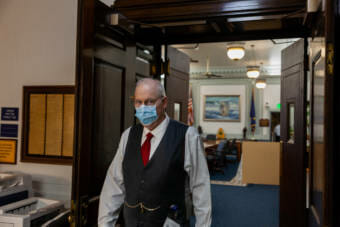
“It’s a lot easier to get a simple majority to rob the Permanent Fund than it is to get votes to do taxes,” said Sitka Republican Sen. Bert Stedman. “There’s no other savings left after this year.”
Neither proposal to overspend from the Permanent Fund is final.
The Senate’s proposed PFD must be approved by the House and signed by the governor before taking effect. And Dunleavy’s plan has drawn a tepid reaction from lawmakers, who must approve a Constitutional amendment by a two-thirds majority to send it to the public for a vote.
Nonetheless, the twin proposals underscore the rising pressure from lawmakers to violate their own spending cap — and the long-term consequences of doing so. Every $1 billion withdrawn from Permanent Fund costs the state $50 million in yearly revenues in the future, forever, assuming lawmakers ultimately agree on annual spending of 5% of its overall value.
That means the Senate’s plan, with its $1.5 billion in overspending, would force Alaskans to pay $75 million in taxes each year to make up for the lost revenue — or to accept $75 million in cuts to state programs. Dunleavy’s plan, with its $3 billion in extra spending, would force $150 million in budget cuts or future taxes.
That’s beyond the cuts or taxes needed to fix the state’s lingering structural budget deficit, which the Legislature’s nonpartisan budget analysts estimate at $1 billion under Dunleavy’s proposal.
Opponents of overspending from the Permanent Fund argue that it’s shortsighted and places unfair demands on future Alaskans to pay for generous dividend checks for the Alaskans of today.
Making up the $150 million in yearly revenues sacrificed by Dunleavy’s plan would require each of Alaska’s 730,000 residents to pay $200 in yearly taxes or to give up that much of their dividends. Alternatively, lawmakers could completely eliminate their annual unrestricted general fund spending on the departments of natural resources ($65 million), fish and game ($50 million), and environmental conservation ($15 million), and the gap still wouldn’t be closed.
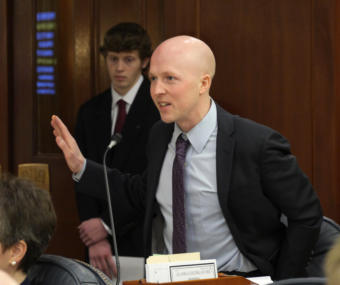
“Pick your poison: It’s poisonous. It’s all bad, it all hurts you. It’s objectively stupid,” said Sitka Democratic Rep. Jonathan Kreiss-Tomkins, who called overspending “generationally selfish.”
“There’s no good argument for spending down your savings,” he added. “Just as outside of the rarest and most fleeting of circumstances in life, there’s no good argument for liquidating your retirement account at age 37.”
Backers of the Senate’s and governor’s plans offer a range of supporting arguments.
In an interview, Anchorage Republican Sen. Roger Holland said that the unprecedented economic hit from the COVID-19 pandemic justifies the one-time, $1.5 billion in overspending on dividends. He also indicated that he’d be unlikely to support such a step in the future.
Holland, a freshman senator who made larger PFDs part of his campaign platform, said he’s been hearing from Alaskans who are struggling to make payments on commercial properties where tenants have stopped paying rent.
“There are businesses that are shutting down that won’t be reopening. And if you were ever going to help the private sector and try to give a real boost to the Alaskan economy, now would be the time to do it,” he said.
Dunleavy’s administration argues that lawmakers need the $3 billion in overspending to give them time to settle their long-running disputes over the size of the dividend, before they move on to negotiations about taxes or future spending cuts.
The governor’s new proposal aims to end the dividend debate by putting it in the Constitution: Half of the Permanent Fund’s annual spending would be dedicated to PFDs, leaving the rest for government spending.
Without that certainty around the dividend, Dunleavy’s administration argues, it’s too soon to adopt taxes or spending cuts because lawmakers won’t know how large they should be.
In the meantime, Dunleavy’s administration projects the state will face a total of $2.8 billion in deficits over the next three fiscal years, which would be filled with overspending from the Permanent Fund.

